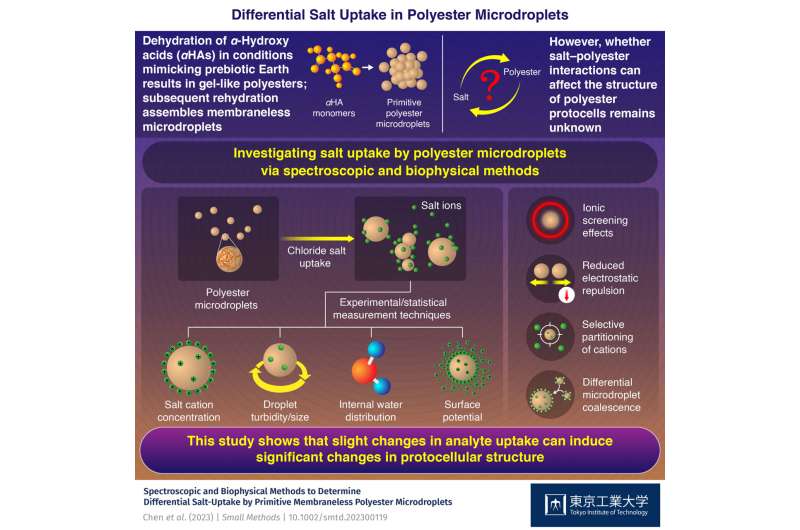
Billions of years ago, Earth was an extremely hostile planet with active volcanoes, a harsh atmosphere, and no life. This prebiotic Earth, however, was filled with a wide array of abiotic organic molecules derived from its early environment, which underwent chemical reactions that eventually led to the origin of life.
A class of such abiotic molecules abundant during the prebiotic era was the ?-hydroxy acid (?HA)–monomers with structures somewhat similar to those of the ?-amino acids essential to modern life. However, their present abundance in biology is low.
Polyester microdroplets generated from dehydration and rehydration of ?HA monomers were proposed as protocell models and could have been a type of primitive compartment that interacted with and took up various primitive analytes, such as salts within primitive aqueous environments. However, salt–polyester interactions and salt-uptake within polyester microdroplets remains poorly studied due to a lack of appropriate analytical techniques.
To bridge this gap in understanding, a team of researchers led by Special Postdoctoral Researcher Chen Chen from RIKEN (formerly of Tokyo Institute of Technology) and Specially Appointed Associate Professor Tony Z. Jia from the Earth-Life Science Institute at Tokyo Institute of Technology have recently come up with a new strategy for investigating the effect of salt uptake on polyester microdroplets.
Their breakthrough, published in Small Methods, proposed a novel way of using existing spectroscopic and biophysical methods to characterize salt uptake by polyester microdroplets and understand their salt-mediated behavior.
“Primitive molecules such as ?HAs and polyesters, though not as commonly used by current living systems as amino acids, may have laid the ground for the evolution of primitive chemical systems that led to the origin of life on Earth. Examining the interaction of polyesters with different prebiotic analytes such as salts and determining whether polyester droplets can uptake salts can provide insights into the relevant functions exhibited by primitive compartments,” explains Prof. Jia.
?HAs such as ᴅʟ-3-phenyllactic acid (PA) can undergo dehydration under early Earth mimicking conditions to form gel-like polyesters; further rehydration results in assembly of membraneless microdroplets. These membraneless droplets have previously been found to segregate primitive analytes such as nucleic acids, small organic molecules, and proteins.
Studies have hypothesized that life originated and evolved in ancient aqueous environments. If polyester microdroplets existed in primitive aqueous environments, then they might have also uptaken salts, a major analyte found in primitive aqueous environments, which could have subsequently changed the microdroplets’ structure as well.
Thus, the team subjected various ?HAs, such as PA (a neutral monomer), malic acid (a monomer with an acidic side chain), and 4-amino-2-hydroxybutyric acid (a monomer with a basic side chain) to dehydration synthesis, followed by rehydration in aqueous medium to generate neutral, acidic residue-containing, and basic residue-containing polyester microdroplets.
In fact, this study was the first to show the plausibility of acidic residue-containing polyester microdroplets! They then incubated the polyester microdroplets in aqueous solutions consisting of different concentrations of different chloride salts (NaCl, KCl, MgCl2, and CaCl2) that may have been abundant in early oceans.
Post salt uptake, the polyester microdroplets were subjected to a novel analytical technique utilizing inductively coupled plasma mass spectrometry (ICP–MS) to analyze the salt cation concentration within the microdroplets. The analyses were performed in collaboration with researchers from the Pheasant Memorial Lab at the Institute of Planetary Materials at Okayama University, where the ICP–MS was located, as part of a joint use collaborative grant.
Furthermore, in collaboration with other members, each with unique specialties, the team then coupled ICP–MS with other spectroscopic and biophysical analytical methods, such as zeta potential analysis, optical density, dynamic light scattering, and micro-Raman imaging to study in detail how salt uptake affects the surface potential, droplet turbidity, size, and internal water distribution, respectively, of the microdroplets.
The results indicated that microdroplets possessed the ability to selectively partition salt cations, leading to differential coalescence of microdroplets, likely due to reduced electrostatic repulsions between the microdroplets as a result of surface charge neutralization by the uptaken salts, which preferentially localized to the droplet surface.
The present study highlights that even slight changes in salt-uptake could significantly affect protocell structure, which could potentially account for diversity in chemistries of primitive systems that emerged in different aqueous systems—ranging from freshwater to oceanic to hypersaline under-ocean brines.
“The adoption of a novel and highly sensitive strategy for analyzing salt uptake by polyester microdroplets widened the range of known primitive chemicals that could have had an effect on primitive protocell structure and function. This opens new avenues for future investigations regarding the relevance of polyester microdroplets during the origins of life both on and off Earth,” concludes Dr. Chen.
More information: Chen Chen et al, Spectroscopic and Biophysical Methods to Determine Differential Salt‐Uptake by Primitive Membraneless Polyester Microdroplets, Small Methods (2023). DOI: 10.1002/smtd.202300119
Journal information: Small Methods
Provided by Tokyo Institute of Technology

